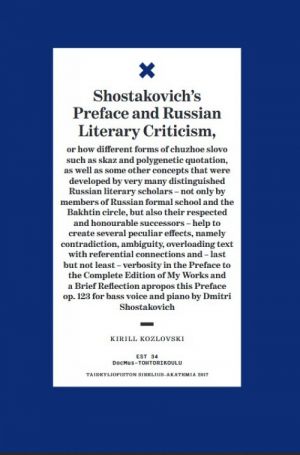The thesis is an analysis of Dmitri Shostakovich’s op. 123 using a methodological framework taken from writings of Russian literary critics of the early 20th century and their followers.
In the first chapter several key notions are introduced and contextualised – namely, polygenetic quotation, skaz and ambiguity. The claim is stated, that Preface could be analysed in the similar way to Boris Eikhenbaum’s analysis of Gogol’s Shinel.
The second chapter is dedicated to analysing and contextualising four musical polygenetic quotations (Mints) in Preface. Quotation sources are mostly works by Mussorgsky (Boris Godunov, Seminarist) and Shostakovich himself (Kazn’ Stepana Razina, Satiry, 13th Symphony).
In the third chapter parallels are drawn between the skaz technique of Mikhail Zoshchenko and certain aspects of Preface – both verbal and musical. Verbosity, tautology, usage of bureaucratic lexis as well as similarities of syntactic structures are compared in Zoshchenko’s stories and Shostakovich’s Preface. Verbosity is seen as a metaphoric “death of words”, therefore different aspects of death – both artistic or physical – are reflected upon.
The thesis is an analysis of Dmitri Shostakovich’s op. 123 using a methodological framework taken from writings of Russian literary critics of the early 20th century and their followers.
In the first chapter several key notions are introduced and contextualised – namely, polygenetic quotation, skaz and ambiguity. The claim is stated, that Preface could be analysed in the similar way to Boris Eikhenbaum’s analysis of Gogol’s Shinel.
The second chapter is dedicated to analysing and contextualising four musical polygenetic quotations (Mints) in Preface. Quotation sources are mostly works by Mussorgsky (Boris Godunov, Seminarist) and Shostakovich himself (Kazn’ Stepana Razina, Satiry, 13th Symphony).
In the third chapter parallels are drawn between the skaz technique of Mikhail Zoshchenko and certain aspects of Preface – both verbal and musical. Verbosity, tautology, usage of bureaucratic lexis as well as similarities of syntactic structures are compared in Zoshchenko’s stories and Shostakovich’s Preface. Verbosity is seen as a metaphoric “death of words”, therefore different aspects of death – both artistic or physical – are reflected upon.













